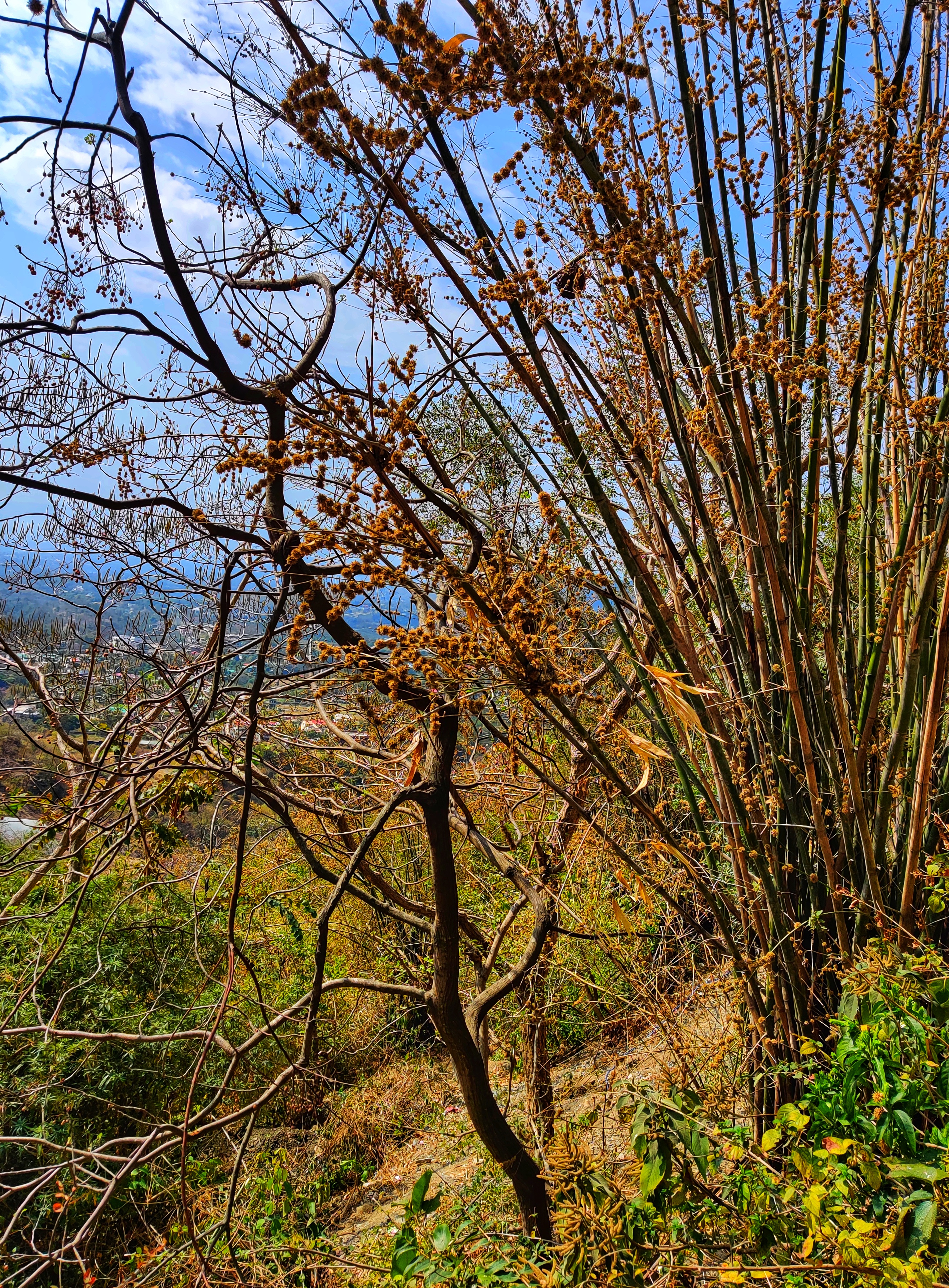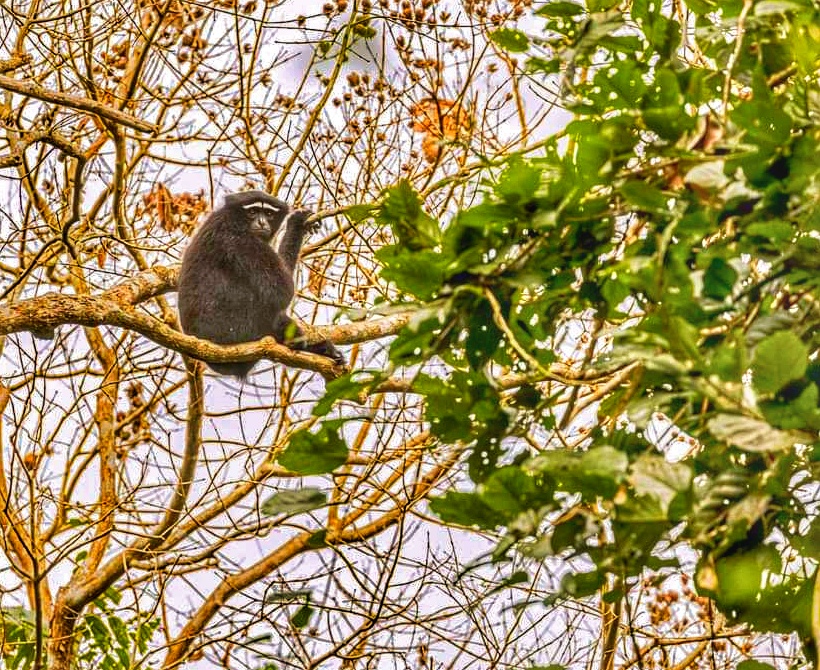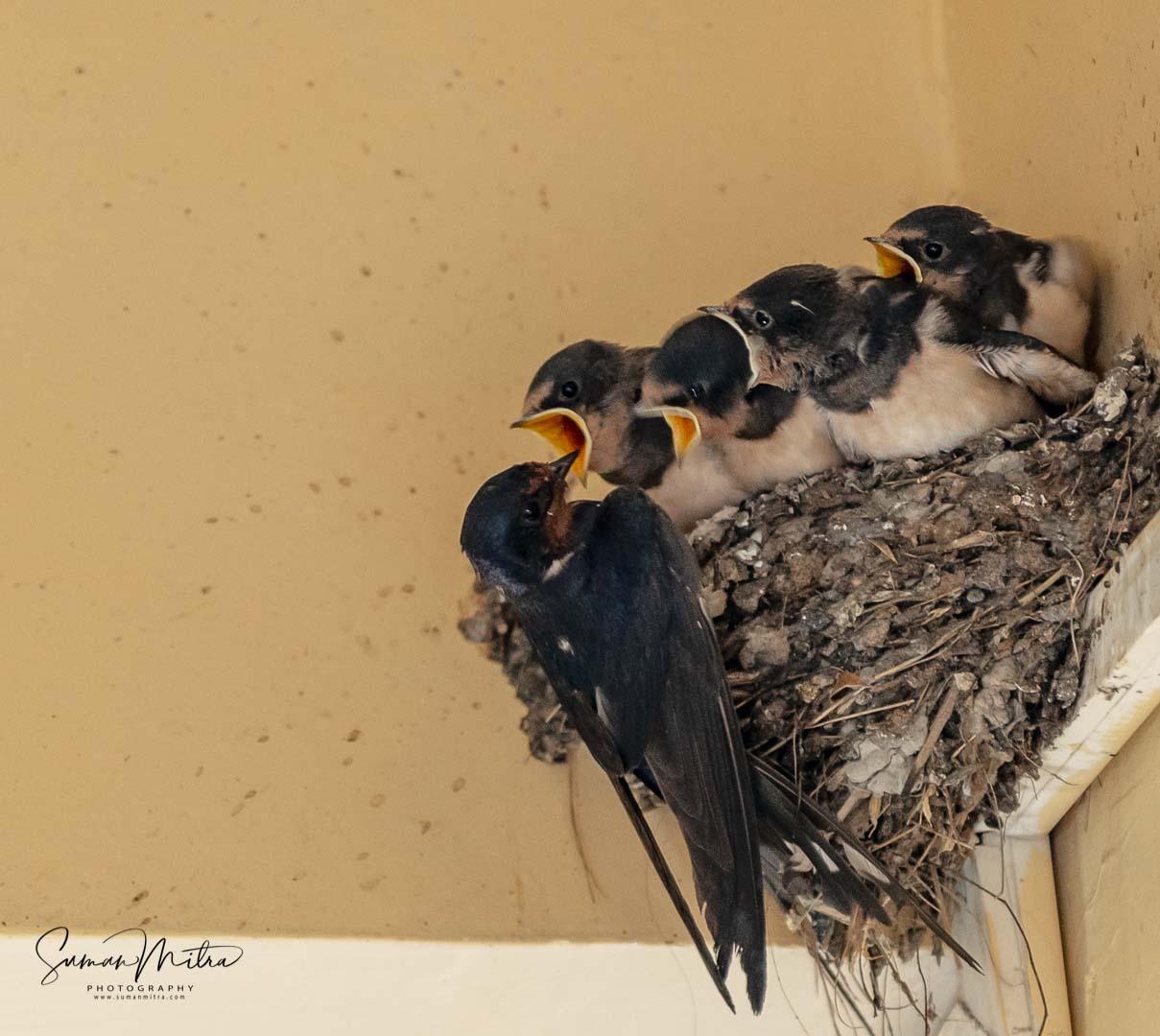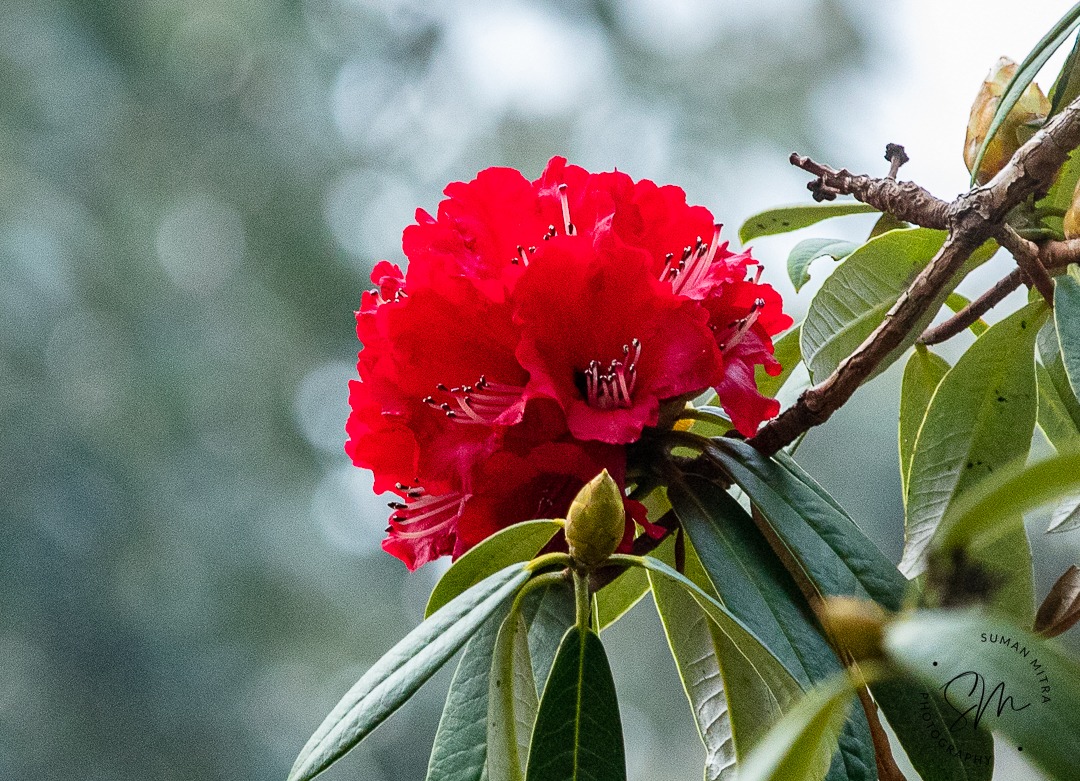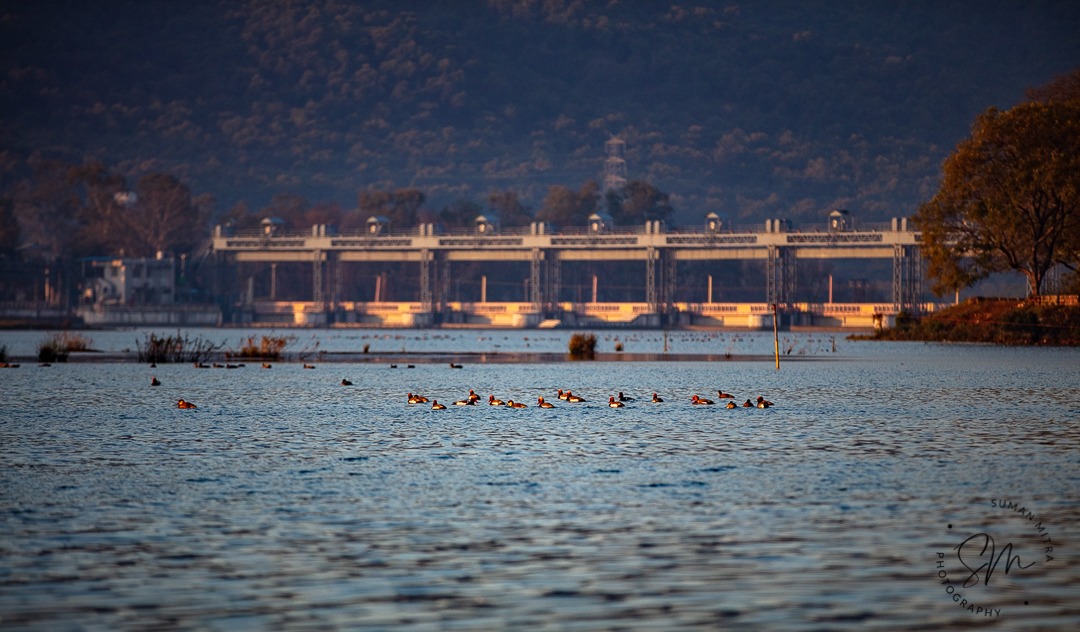With the onset of spring season, the flowering season in Mussoorie has begun. But today, I was startled by the sight of Bamboo flowering along the hilly roadside of key roadway connecting Mussoorie and Dehradun (Mussoorie to Dehradun road). I was happy to see flowers of bamboo, as its a rare phenomenon but at the same intrigued also, because flowering in bamboo is not considered as a good omen in different parts of the world. The bamboo clump (Dendrocalamus sp.) was overladen with flowers depicting monocarpic flowering. I am thankful to Dr. Sas Biswas for kindly identifying the bamboo. The flowering of bamboo has always drawn interest of botanists and foresters. Kahkashan Naseem, IFS, Mussoorie Forest Division confirmed that it’s synchronous flowering. She also told that Bamboo board of Uttarakhand in year 2019 have given an alert not to plant Bamboo species as it will get ruined. The phenomena of bamboo flowering and fruiting has been recorded over 2000 years in ancient Chinese texts. The mention of Bamboo is also there in the ancient Hindu texts also. The first bamboo classification was given by Rumpf in the year 1750, who divided the bamboos into eight classes with the name Arundo. Later, Linnaeus used the name “Arundo bambos,” which included all the bamboos. Nees, in the year 1829 described bamboo inflorescence as a distinct structural unit. There is a regular schedule of flowering in different species of Bamboos. Sometimes, it takes 50 to 100 years to see bamboo produce flowers and eventually plant will die off and reseed. While, sometimes bamboos flower multiple times before dying. But, it a matter of grave concern when there is gregarious or mass synchronous flowering and subsequent death of the plant. In Northeast India, the flowering of Bamboo is usually considered a bad omen. According to ancient belief, bamboo flowering indicates death, destruction, famine, increased pest and rodent attacks. In Northeastern states of Tripura, Mizoram and Manipur, after every 48-50 years, there is Mautam, which is a cyclic ecological phenomenon where flowering of bamboo triggers famine. In the year, 2009, different species of bamboo flowered in Arunachal Pradesh like Bambosa balcooa, B. tulda, Dendrocalamus hamiltonii, and Stapletonia arunachalensis which resulted in rodent outbreaks causing severe damage to many crops (Kumawat et al., 2014). Hence, much attention is given towards bamboo flowering for its scientific importance as well as future implications. The location where I observed bamboo flowering in Dendrocalamus sp. had monocarpic flowering, but later with the help of Forest Department of Mussoorie, I confirmed that it’s a synchronous monocarpic flowering in bamboo. In monocarpic flowering, bamboo plant will flower, go to seed, and then die. It’s characteristic of annual plants which have one growing season, then flower and die within the year. Most botanists will classify bamboo as monocarpic, but the issue remains somewhat unclear.The vicinity areas and localities should be explored for the bamboo flowering and locational studies should be conducted. According to the literature (Zhou, 1984; Du et al., 2000; Yuan et al., 2005, 2008, 2012; Franklin, 2010), sporadic flowering often occurs in cultivated or intensively managed bamboo species, which flower sporadically more often than wild species. Various research on bamboo flowering and inflorescence characteristics are widely used in the classification of bamboo. Also, studies has already been conducted with respect to bamboo, including flowering cycle, flowering habits, factors resulting in flowering, die-back and recovery, rejuvenation, and the effects of bamboo flowering. Bamboo, also known as poor man’s timber has multiple uses and forms an integral part of social, cultural and economic life of the people. Earlier bamboo was categorized as tree , but after amendment of Section 2(7) of Indian Forest Act, 1927, bamboo is no longer a tree and felled bamboo too is not timber. With more than 130 species of bamboo in India, there is an immense potential to increase the productivity of bamboo resources and utilize it for increased value addition to generate employment and economic activities, primarily in rural areas. Bamboo has both tangible and intangible benefits and can also be used in soil conservation. Climate change has adverse affect on the global ecosystems and Mussoorie and nearby areas are already facing it’s repercussion. The green cover and biodiversity enroute Mussoorie via Dehradun has been drastically affected due to rapid urbanization, irresponsible tourism, roadway extension to curb ever increasing traffic. The loss in the vegetation will pave ways for future landslides and mass wasting. Varying rainfall patterns and gradual rise in atmospheric temperature may trigger water shortage and hotter summers. Nature has its own way of signaling disasters. Birds fly before earthquake, Bamboo flowers before disasters. Since time immemorial, the signs and signals given by nature and wildlife has averted many disasters. It’s important for us to recognize and decipher the signs and act judiciously to prevent and further protect our race. The demand of the hour is to act responsibly, before it’s too late. Thank you!! @chandrimadebi Picture courtesy https://www.facebook.com/SumanMitraPhotography https://www.sumanmitra.com/copyright @sumanmitraphotography All images and content are subjected to copyright © 2019 – 2021 chandrimadebi.com
Land where Hoolock Gibbon sings: Hollongapar Gibbon Sanctuary, Assam
It was summer of 2015 in Hollongapar Gibbon Sanctuary, Assam. I was a doctoral student at that time and was working towards the conservation of a medicinal forest tree species in the rain forests of Assam. For some study purpose we were traversing through dense forest trails and I was accompanied by my colleague and one forest guard. While I was lost in exploring the rich biodiversity, our forest guard suddenly stopped and pointed up in the branches of Hollong (Dipterocarpus macrocarpus) trees and slowly whispered to us ‘holou’. In Assamese language Hoolock Gibbons are called as ‘Holou bandor’ (although they are not monkeys). Western Hoolock Gibbon also known as white-browed gibbons are the only apes of the Indian subcontinent. I looked up in the branches and was mesmerized to see a pair Hoolock Gibbon sitting high up on the tree branches. The couple was holding each other and caressing. The moisture laden wind was blowing through the swaying branches and our eyes met. I tried to get the moment clicked, but somehow the mystical ape slowly moved into the thicker canopy and could not be traced. I was overwhelmed by the very sight when I first saw Hoolock Gibbon in its natural habitat, so serene, so innocent. We followed the trail ahead, and the pitter patter of the raindrops on the broad leaves already started. It takes some time to reach the raindrops on the ground due to thick canopy. The forest floor was covered with high litter and biomass, not to mention abundant leeches too. Sometimes leeches help safeguard against illegal poaching and tree felling. Summers in these moist forests are usually hot, humid and sweaty alongwith mosquitoes and flies. Moreover, rainfall plays hide and seek althroughout the day. The upper canopy of the forest was dominated by the Hollong tree (Dipterocarpus macrocarpus), while the middle canopy was dominated by Nahar (Mesua ferrea). The lower canopy comprised of evergreen shrubs and herbs, bamboos and rattans. Hollong tree is one of the favourite trees of Hoolock Gibbon. I too love Hollong and Mesua (Nahor gos) trees due to their phenology, colour patterns, cultural, ethnic and economic importance. On the way, the elderly forest guard told us that the Hoolock Gibbons are mystical and shy but social creatures. They are monogamous and mate for life and form strong family bonds. The mated pairs stay together for several years and their family usually comprises of one adult male and one adult female and their offspring. He told that the adult male reaches out to adult female family and convinces her father to give away her daughter (just like social marriage). If the girl’s father is convinced then both male and female adults can start their own family otherwise, the couple elopes and leaves their family to start their own. Female often gives birth to a single offspring within three years and caresses the infant. Juveniles slowly develop thick white ring around their face and develop their art of singing. The mother and offsprings share close bond even when distance apart. After attaining adulthood, males frequently perform solos, singing, and females perform duets with adult males. Adult males have dark pelage while adult females have lighter pelage. Gibbons communicate with each other through songs. The morning or evening opera consists of a repeated series of hoots and hoops ‘whoo- whoo‘ can be heard several miles away. They have a unique way of singing notes which has varying significance for eg. to attract potential partners or to announce occupied territory. The Western Hoolock Gibbon is found in all the states of the north-east India but is restricted between south of the Brahmaputra river and east of the Dibang river. It is also found in east Bangladesh and north west Myanmar. Western Hoolock Gibbons are strictly arboreal and swing and can walk upright also. In Assam and different parts of Northeast India, it’s considered a bad omen if Hoolock Gibbon comes down on earth. Being omnivorous, they love to have fruits, leaves and insects. They help in pollination as well as dispersal of seeds, thus balance forest ecosystem. They prefer to spend their night sleeping on the tallest trees and descend from their sleeping sites during early morning hours, to the valley below where they like to forage. After feeding, they sing for sometime. The Western Hoolock Gibbon is listed as Endangered in the IUCN Redlist. Their population is gradually declining by almost 90% over the last 30 years, due to deforestation, habitat destruction, forest fragmentation, hunting for meat, poor availability of food and it is now considered to be one of the most endangered 25 primate species in the world. In India, its listed on Schedule 1 of the Indian (Wildlife) Protection Act 1972. In order to protect further decline in the population of the species, the Government of Assam upgraded the status of the Hoollongapar Reserve Forest in the Jorhat District of Assam to a Protected Area for the conservation of these lesser apes. Presently, there are many ongoing research and conservation activities being undertaken towards behavioural studies as well as conservation of the endangered lesser ape species in India. I wonder to what extent human beings can be selfish and greedy to hamper and ruin innocent lives and habitat of Hoolock Gibbons. The sun was going down and we had to return back to our research centres. We followed the trail back, but there was no sign of Hoolock Gibbons, they might have climbed up high tree tops as night was approaching, although I could smell wild elephants nearby. I was hoping that for once I could see the Gibbon and boarded vehicle. And to my surprise I could listen the song of Hoolock Gibbon from a distance as if they were saying goodbye. I thanked the scintillating moment and left with a hope to meet again. Throughout, the journey, I was wondering, how Gibbons being an ape can be loyal to their partner and spend their entire life altogether.
A plateau losing green forest cover: Karbi Anglong district, Assam
In the remote North-eastern corner of the Indian subcontinent lies the beautiful district of Karbi Anglong. The plateau is dominantly inhabited by the Karbi tribes hence the name Karbi Anglong. The Karbis are the indigenous inhabitants of the region and ‘Anglong’ is a Karbi noun for “hills.” The region is flanked by numerous rivers and tributaries like Dhansiri, Longnit, Jamuna, Kolioni, Nambor, etc. The district is bordered by Golaghat district on the east, Meghalaya state and Morigaon district on the west, Nagaon and Golaghat districts on the north and Dima Hasao district and Nagaland state on the south. Major part of the district is covered with forest which constitute about 41.12% of geographical area . The panoramic view of the forests in the Karbi Anglong instils everlasting sense of wilderness and tranquility. The forests, rich in biodiversity comprise of rare, endemic and endangered species of plants and animals and has always attracted naturalists and researchers to quench their thirst of plethora of knowledge. The forests are known to be inhabited by the Asian elephant, Bengal tiger, Clouded leopard and Leopard, Hoolock gibbon, Pangolin, Porcupine Slow loris etc. alongwith with diverse species of butterflies, moths and birds. The river channels, rivulets, streams, creeks, brooks comprise of different species of fish as well as colourful fish (some fish species might not yet have been discovered yet). The major forest types found in Karbi Anglong District comprise of Moist semi-evergreen forests, Moist Mixed Deciduous forests, Riverain Type and Miscellaneous type with scattered pure or mixed patches of bamboos, alongwith, five wildlife sanctuaries, two elephant reserves (Dhansiri – Lumding and Kaziranga – Karbi Anglong) and 17 District Council Reserve Forests (DCRFs); Garampani Wildlife Sanctuary, East Karbi-Anglong Wildlife Sanctuary, Marat Longri Wildlife Sanctuary, Nambor Wildlife Sanctuary and North Karbi-Anglong Wildlife Sanctuary. The forests and the forest fringe villages in Karbi Anglong district have ‘Sacred groves’, which are intact forest areas backed by people’s beliefs. The tribal people of the Karbi Anglong district believe that each object has its own spirit which is omnipresent and worship the spirits of a particular space or area (forest) called ‘Longri Arnam’ (Territorial Deities). ‘Longri Arnam’ is also known as ‘Than’ in Assamese, which is a sacred grove where the spirits or deities reside in a particular space or area (forest). In Northeast India, many sacred groves have been already reported in Karbi Anglong, Assam (Tripathi, 2001; Khan et al. 2008). Karbi Anglong has a contiguous landscape with world heritage site Kaziranga National Park. The district is also a high priority area for long-term conservation of the Western Hoolock gibbon, one of the two species of lesser-known apes found in the Northeast India. One of the crucial roles played by Karbi Anglong is that its highlands provide shelter to wildlife from Kaziranga during floods. The rich natural vegetation and forests are an important part in the life-process of the tribal population and forms an indispensable part in the life of the Karbis. The life and economy of the tribal people in the division is intimately connected with the forests. Majority of the tribal population in the division depends on the forests and make a living out of the forest produce collected by them; mainly edible roots and tubers and by hunting small animals. The forests provide the tribals and other communities living close to the forest habitat, shelter, raw materials for household equipment. Slowly the dependence of the local on the forest has significantly increased. There has been sudden shift from forestry to agriculture in the division which has resulted in massive deforestation. Lack of alternative livelihood for some and greed on the part of unscrupulous traders has led to gradual denudation of the forests. The link between human poverty and environmental degradation is also one of the important factors behind deforestation. Deforestation is partly attributed to shifting cultivation practices (i.e., slash and burn, locally referred as jhum cultivation) and partly due to practices like illegal felling of trees, mining, conversion of forest land into agriculture land, poverty and encroachment. Indirectly, deforestation has triggered micro climate change, high rate of soil erosion, floods, increased report of man elephant conflict and loss of biodiversity in the district. Government initiatives have not yet trickled down to the ground level so as to ensure proper management of forests and livelihood upliftment so as to reduce dependency on forests. Tribal societies still practice shifting cultivation/Jhoom cultivation which has incurred loss of biodiversity. Conversion of forest land into agriculture land like tea, orange and rubber plantation has caused depletion of a large forest area. Due to the present spate of growth of small tea gardens, large forest cover paved way to tea plantation, thus causing further shrinkage in the total forest area. Area under Forests and grasslands shrunk by the expansion on settled agricultural practice. To compensate the forest cover, Teak (Tectona grandis), Gamari (Gmelina arborea), Titasopa (Michelia champaca) Simul (Bombax ceiba), Udal (Sterculia villosa) Ajhar (Lagerstroemia flos- reginae) and Pine (Pinus khasya) etc. have been planted in the district to augment the green cover. Deforestation has emerged as one of the major concerns of the world community as significant environmental impacts are attributed to it. The association between population surge and deforestation in most of the developing countries has intensified the concern on deforestation. There are reports which infer that deforestation and loss of wildlife habitat in upper Assam is likely to influence not only the adjoining Bhutan and Arunachal Pradesh, but also lower Assam so far as the wildlife and ecosystems are concerned. The human lives and forests are interconnected. Therefore, forests need to be reinstated to their original status for long-term subsistence of humans and wildlife. Thank you!! @chandrimadebi Picture courtesy internet ©content subjected to copyright
An ode to the Swallows!!!
Swallows flying high,Up above in the sky;Swooshing through the mountains,Diving in the valley deep;To catch insects swarming in the air,with a velocity steep. ***** Agile and alert are your actions,Random turn sometimes;I couldn’t follow your flying course,Lost track many times!!! ***** Off you fly from your cozy nest,Into the trees surround;Next moment you are out of sight,Flying somewhere around. ***** People believe you bring good luck,To the place you breed;Little nests, along the concrete wall and ceiling,Artist or an architect, from where you learn these skills? ***** Laying eggs, nursing babies,care and protection you provide;You ward away many predators,Chasing them away, until they hide. ***** Yesterday, I saw you alongwith your babies,You were teaching them how to fly;To survive, to struggle and persevere,Till they are ready to soar up high in the sky. ***** The rapid urbanisation sufficing human selfishness,has snatched away your home;And forced you to make your nest in the artificial biome. ***** But you are adapting to the ecological changes,I doubt whether we humans will be;Swallows flying high up in the sky,Next season will you come to visit usor may be? ***** Thank you!!!!! Picture courtesy https://www.sumanmitra.com/ © images and content are subjected to copyright (Images were clicked using Canon EOS 5DS R, from a safe distance without intimidating the birds)
Rhododendrons in the hillside
Swaying with the whistling breeze,Spreading your charm;You fulfill wilderness dreams, giving memories warm. Birds, animals and honey bees cherish your nectar,They come to visit you from lands afar;Laden with beauty and healer are you,Life support system for many though. The fallen petals on the forest floor,Create a mystical hue;A path painted red,leading somewhere, I have no clue!!! Here comes spring and the season of flowering begins;Shades of yellow, white and pink in the forests;Alongwith rhododendron flowering It’s Valentine’s Day!!Some gift roses, some gift tulips;Some geraniums, jasmine too.But he gifted me Rhododendrons; flowering high up above the tree;He climbed up the trees to fetch the flowers especially for me.Red Rhododendrons filled with love, so beautiful are you thee!!! PS Due to global climate change, early blooming of Rhododendrons was observed in the lesser Himalayas (Landour, Mussoorie). The Rhododendrons are usually are in full bloom during the month of March , but this year they started flowering since the end January. Climate change will have adverse affect on the pollination ecology alongwith bird and insect behaviour. Thank you!! Like, share and follow. ? https://www.facebook.com/Dr.ChandrimaDebi/ https://www.instagram.com/debichandrima/ https://www.sumanmitra.com/ ©All images and content are subjected to copyright © 2022 chandrimadebi https://chandrimadebi.com
Snowfall in winter night ; Landour, Mussoorie
Even though late, it snowed in Landour, Mussoorie yesterday, this year. Watching snowfall is an enchanting experience. Like little fairies hopping from branches and leaves finally falling on the ground to create fluffy bed, soft and delicate. I wonder how deep is the connection of snow is with forest and trees. Snowfall is very shy and mysterious here in the woods. The scenic beauty enlivened few verses of my inspirational poet since childhood, Robert Frost and his poem ‘ Stopping by Woods on a Snowy Evening’. Words reiterated and crossed my mind and here I am, penning them down… Little flakes of snow falling silently on the ground;Painting the landscape white, without making any sound. On the Oak trees, Deodar, Spruce and Pine;Hopping from the branches, kissing leaves, Divine. Soft, delicate and mystical are you thee;And you decide where you want to flee. I saw a foot trail, but couldn’t find the clue;You must have covered them all the night through. Blessings from the heaven or little fairies are you;Falling from the sky, creating whitish hue. White, the colour of purity and peace;Next winter snowfall, visit me again please!!! Climate change is taking toll in the Himalayas with delayed snowfall affecting ecological changes. I hope with the snowfall, the water table in this little hillside of Landour, Mussoorie will get recharged. The trees and forests will get ample water, the Rhododendrons will thrive and the honey bees coming from far off lands will have ample nectar and will not return empty handed. Whose woods these are I think I know. His house is in the village though; He will not see me stopping here To watch his woods fill up with snow. The woods are lovely, dark and deep, But I have promises to keep, And miles to go before I sleep, And miles to go before I sleep. By Robert Frost Thank you!! @chandrimadebi Picture courtesy https://www.facebook.com/SumanMitraPhotography https://www.sumanmitra.com/copyright @sumanmitraphotography ©All images and content are subjected to copyright
Asan Conservation Reserve/Asan Barrage, Uttarakhand: A man-made lake or nature’s delight
Situated at the confluence of the Asan river and Eastern Yamuna Canal alongside bordering states of Uttarakhand-Himachal lies the Asan Conservation Reserve/ Asan Barrage or Assan Barrage. This barrage created the Asan Reservoir which is also called Dhalipur Lake, and was developed in 1967 when the Dhalipur power house was under construction. The scenic geographical location and the azure blue waters has long drawn the the interests of the conservationists, bird watchers, photographers and tourists too. Asan wetland is home to around 330 species of birds (including some rare species). Critically endangered species like white-rumped vulture (Gyps bengalensis), red-headed vulture (Sarcogyps calvus), and Baer’s pochard (Aythya baeri) are found here. The migratory birds listed as globally endangered species in the IUCN’s Red Data Book like- Brahminy Duck, Pintail, Red Crested Pochard, Gadwall, Common Pochard, Mallard, Coot, Wigeon, Common Teal, Tufted Duck, Shoveller- travelling from Central Asia also take shelter for about four – months in the lake. It is also home to about 49 fish species, including endangered Putitor mahseer (Tor putitora). Asan wetland is rich in biological diversity. In the year 2020, Asan barrage also known as Asan Conservation Reserve was declared to be the first Ramsar site from Uttarakhand state, India. Ramsar is a city in Iran where the first World Convention on Wetlands was held on 2 February 1971.The Ramsar Convention defines wetlands as ‘Wetlands are area of marsh, fen, peatland or water, whether natural or artificial, permanent or temporary, with water that is static or flowing, fresh, brackish or salt, including areas of marine water, the depth of which at low tide does not exceed six metres.’ Wetlands support many different types of plant and animal species.They naturally filter our water. Wetlands are areas where the water meets the land. They are a transition between dry land areas and deeper water areas. As a result, some wetlands hold water year-round while others may only hold water for one or two months each spring. But wetlands are facing many threats owing to biotic and abiotic factors such as: • Uncontrolled siltation and weed infestation.• Uncontrolled discharge of waste water, industrial effluents, surface run-off, etc. resulting in proliferation of aquatic weeds, which adversely affect the flora and fauna.• Tree felling for fuel wood and wood products causes soil loss affecting rainfall pattern, loss of various aquatic species due to water-level fluctuation. Uncontrolled siltation and weed infestation• Habitat destruction leading to loss of fish and decrease in number of migratory birds.• Encroachment resulting in shrinkage of area.• Anthropogenic pressures resulting in habitat destruction and loss of biodiversity.• Uncontrolled dredging resulting in successional changes.• Hydrological intervention resulting in loss of aquifers.• Pollution from point and non-point sources resulting in deterioration of water quality. Ill-effects of fertilizers and insecticides used in adjoining agricultural fields. India being a mega-diversity country, so far managed to delineate only few sites till date. According to one report of WWF nearly 70 percent of wetlands in the state have degraded due to negligence. Excessive tourism pressure with trekkers camping at the site, spreading of filth and pollutants in the water body and extreme grazing pressure by shepherds have contributed to the destruction of these wetlands. There is obviously much ground to be covered in our conservation efforts of wetlands. Responsible tourism can aid in upkeeping the serenity. In addition, a paradigm shift in conservation ethic is also a strong need of the hour. This shift is necessary and perhaps mandatory due to the very nature of resource being conserved and protected. Thank you!! @chandrimadebi Picture courtesy https://www.facebook.com/SumanMitraPhotography https://www.sumanmitra.com/copyright @sumanmitraphotography ©All images and content are subjected to copyright

